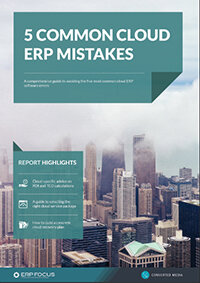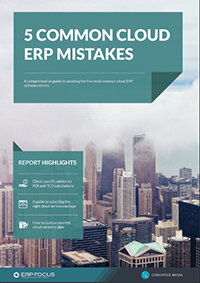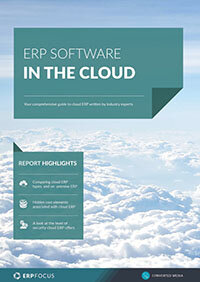Three cloud ERP mistakes your company might be making
Cloud ERP is one of the more important enterprise innovations to come along in some time. An ability to migrate standing operations, in parallel with on-premise processes, allows nearly any enterprise to leverage new innovations and techniques quickly, and at reasonably low price points, represents something heretofore seen by computer-centric businesses.
However, while the new topology allows obvious value, there are numerous potential cloud ERP mistakes that operators should be aware of. Here are just three of them.
1. The cloud can be your friend - but weak planning can blow your buzz up
Today’s public networks offer a host of useful functions when it comes to the evolving enterprise ERP environment including; intrinsic systems scalability, universal multi-point configuration, plenty of demand-driven data storage, direct, and indirect security capabilities and more. However, what the cloud doesn’t offer is an ability to plan an enterprise’s ERP process structures, develop and emplace policies, business rules, operational standards or anything else that makes a ‘system’ run effectively day-after-day. One of the most common cloud ERP mistakes is to assume that your new software will completely iron out human incompetence. It won’t.
Consequently, if you are considering a move away from on-premise ERP and toward cloud-based ERP operations, be aware that just you put all of your “stuff” in the ether, the hard part associated with the ERP value will still reside in an enterprise’s wetware department, not up in the sky.
2. The cloud provides for automated scripting - but malformed KPIs can still screw them up
Key Performance Indicator’s (KPI) represent critical business metrics leading to the practical realization of enterprise goals. As a result, most if not all finite business operations are typically guided by various ‘do this; for what, and/or how much’ formulas ultimately resolving as one or more sets of comparative numbers. For example, annual budget rounds typically establish a number of enterprise ‘actual spending versus expected ROI’ KPIs, at the beginning of each fiscal year.
In the on-premise world, the results of these kinds of KPIs are usually monitored manually by Director-level managers who, in-turn, review, tweak and report necessary results up the administrative chain. However, in the case of the cloud, a lot of the drudgery associated with manipulating KPIs can be off-loaded to automated scripts that compile and delivery requisite reports on a periodic basis.
Nevertheless, if a set KPI framework is malformed or impractical from the outset, such as projecting an expected ROI that is 20X, when 5X is more sensical, it should be considered that any automated system is going to crunch its numbers based whatever garbage goes in, will also result in “garbage” at the output-side as well, leading to a skewed view of what is going on. So, remember that no automated system is ever going to be ‘smarter’ than the people who designed it.
3. The need for speed - the cloud streamlines but it also harbors potential trainwrecks
Everyone wants faster processing so enterprise ERP folks can divine and deliver better intelligence on demand. However, there’s a concern harbored in the cloud-based ERP that is worth watching. The desire for more speed typically equates to greater data volume, and if managers are not familiar with how to use it, impacts here can choke an operation with more information than it can handle.
Consequently, when you begin to leverage cloud operations, it’s probably best to scale up slowly, by utilizing a step-by-step approach until you clearly understand what is, and isn’t helpful, as your enterprise processes begin to pick up speed.
Free white paper

Five common cloud ERP mistakes
Get your comprehensive guide to avoiding the five most common cloud ERP errors

Featured white papers
-

Five common cloud ERP mistakes
Get your comprehensive guide to avoiding the five most common cloud ERP errors
Download -

Related articles
-

Why you shouldn't underestimate cloud ERP consultant costs
Make sure to take the cost of a consultant into account when planning your cloud ERP budget
-

CMMC Compliance: What Aerospace and Defense Manufacturers Need to Know
Key insights on CMMC compliance, deadlines, and securing DoD contracts with CMMC 2.0 certificatio...
-

Cloud ERP vs on-premise ERP: an objective comparison
Are you choosing between cloud ERP and on-premise ERP? This balanced guide will help

